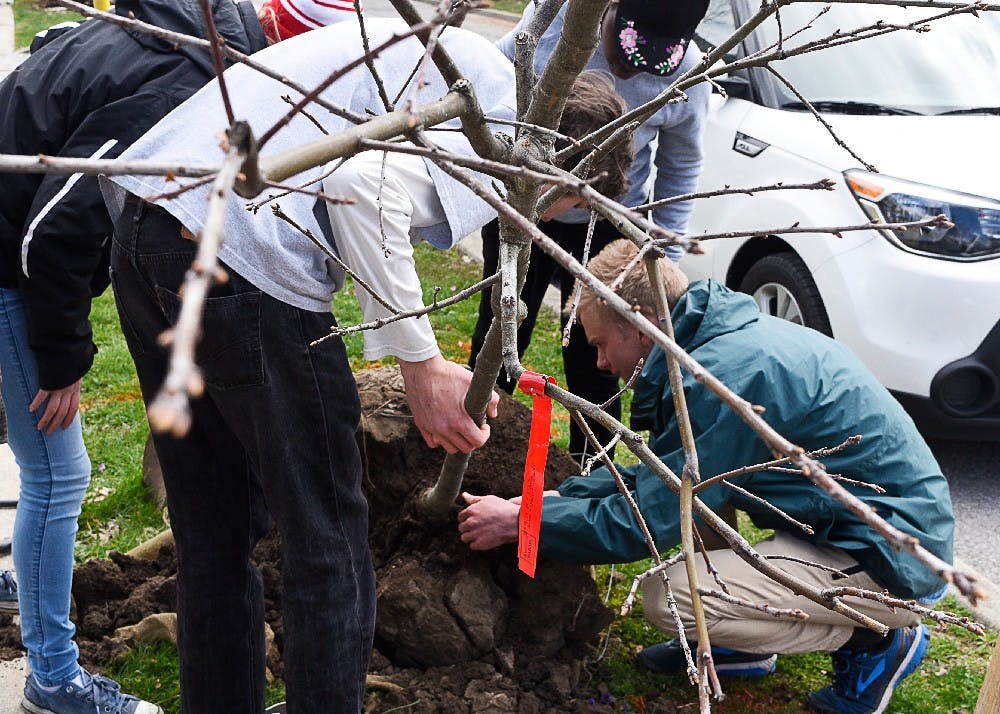Cottage Grove will be home to 28 fully-leafed tulip poplars by June.
The street was the site of professor Burney Fischer’s 13 annual tree planting and the culmination of E422: Urban Forest Management.
“It’s a matter of manpower, more than anything else,” Fischer said.
Tree planting is a critical component of urban forestry, Fischer said, but the activity must wait until late in the semester for appropriate weather. The planting typically coincides with the School of Public and Environmental Affairs’ Earth Week celebration, during which SPEA organized several environmentally themed events leading up to Earth Day on Sunday, April 22.
Bloomington city forester Lee Huss chooses a different location for the class planting every year based on where trees have recently died or been removed.
The average tree lives 39 years, Huss said. In his 35 years as city forester, he has watched trees he planted start to decay.
The city constantly plants trees in the spring and fall to ensure they do not all die at the same time.
“The city has always strived to keep its municipality as tree-loving as possible,” Huss said.
Bloomington has been recognized since 1984 as a Tree City USA by the Arbor Day Foundation, a national nonprofit organization devoted to planting trees.
Cities must have a tree board or department, a tree care ordinance, a budget of at least $2 per capita on urban forestry and an annual Arbor Day celebration to qualify for the distinction.
The IU-Bloomington campus was designated a Tree Campus USA in 2009.
“The campus and the community have always been tree-related,” Huss said.
Huss chose tulip poplars, the state tree the city is promoting as part of the Bicentennial, for Thursday’s planting. This species can be subject to scale insects, which Huss said seldom kill the trees but can discharge a sticky substance onto nearby cars and passerby.
Each tree had a base of soil, wrapped in burlap and a wire basket, weighing more than 50 pounds.
The strength of at least three students was needed to roll the tree and base next to its corresponding hole, pre-dug by city workers.
With advice and physical assistance from Fischer, teams of three to five students used wire cutters to remove the basket. Fischer told students to take off the top layer of the soil until they could see the main root of the tree, signaling how deep to plant it.
Once the wire and burlap were discarded into a plastic tub, the students rolled the tree into the hole and filled in gaps with extra soil.
They finished by adding two bags of mulch, which Fischer said should surround the tree like a donut, not a volcano.
“Use both bags,” Fischer said. “Don’t worry about being cute.”
Fischer said the mulch promotes moisture and deters lawn mowers and weeders, strengthening the tree’s health.
Although ball and burlap is the easiest way to transport trees from nurseries to planting sites, Fischer said the trees will need two or three years to fully recover from their severed roots.
“The first year or two, life isn’t happy,” Fischer said.
In the long run, however, the new trees will provide ecological and practical benefits for the area, Huss said, including environmental resilience and climate change mitigation.
City trees help with air pollution and stormwater reduction, and will shield students from the sun as they walk to class in the summer.
Unlike forests, street trees will not regrow after they die.
“The only way to get new trees is to plant them,” Fischer said.




